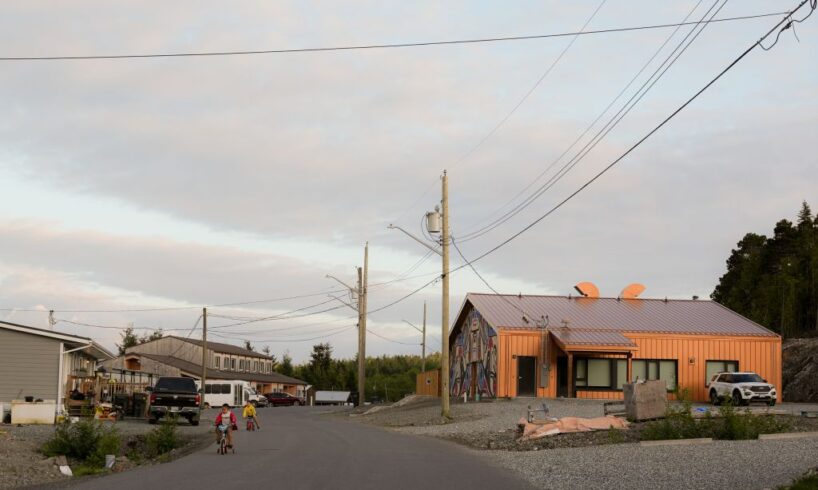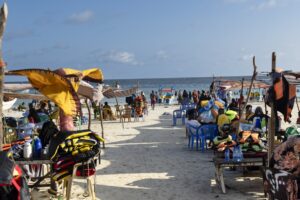
This story is part of Habitat, a series from The Narwhal which looks at how communities are working to address the housing and climate change crises simultaneously
Standing on the streets looking down, the water is always visible — glinting between the corners of homes or branches of trees. Through the calm, ravens are trilling, croaking and clicking, sometimes sounding like water droplets. Eagles circle overhead and sweep low over the houses.
For the Haíɫzaqv, this is home. But their home is changing — temperatures are rising, drought is increasing. Wildfires are burning more violently, animals are struggling. And reliance on fossil fuels — so brief in human history — must come to an end as emissions cause more and more disasters.
The climate crisis is also exacerbating another long-term challenge in Haíɫzaqv: a housing shortage. According to the 2022 community energy plan, the community needs to build 200 homes and grow electrical capacity by 17 per cent by 2031 to accommodate population growth.
Heiltsuk Nation has many families and individuals on its housing wait-list, and is trying to build climate-resilient housing as quick as it can.
Existing housing also needs repairs and improvements to protect residents from wildfire smoke, hotter summers, mold, extreme weather events and other challenges. To address these two crises together, the nation is building and updating homes with climate change in mind.
And after decades of having decisions made for them, Haíɫzaqv is deciding how their homes will look and embedding their values in each step of the process.
“Housing is a human right. It’s imperative we make some progress around ensuring people have adequate housing and that it’s appropriate for the threats that are coming.”
Homes beyond walls
Bella Bella is surrounded by narrow channels, lined with rivers rich with salmon. To the untrained eye, it may look untouched. In truth, it bears stories, ancestral remains, art, archeological remains — all markers of how it’s always been the home of the Heiltsuk people. You just need to know where to look, Brown says. The land is dotted with ancient fish traps, sheltered beaches perfect for villages and rock faces marked with petroglyphs.
It may also look pristine, but bears the scars of a damaged ecosystem. There are fewer fish under that rippling water than there used to be. That beautiful stream runs lower.
“You can’t see what’s under the water. There was an incredible amount of abundance and very rich and resilient ecosystems, which are now hurting,” he says.
In Haíɫzaqv’s relationship with land and water, they have a “proven model of sustainability for the rest of the world,” Haíɫzaqv Hereditary Chief λáλíyasila Frank Brown says.
Brown joined the University of Victoria’s Pacific Institute for Climate Solutions as its Indigenous climate fellow in June. He is also a senior advisor to the Indigenous Leadership Initiative, which advances Indigenous-led conservation working with Indigenous Peoples across Canada.
Not long ago, salmon and herring could feed the community and sustain a commercial fishery. But with the decline of these populations, the nation is abstaining from its commercial herring fishery and considering alternatives like kelp farming, Brown says. Adjusting to the needs of the environment comes naturally — “Our people have been here for such a long time, we’re able to strike the balance to be able to work within the natural capital systems,” he adds.
Those principles inform the Heiltsuk Climate Action team’s work, which created a community energy plan for the nation. Brown sits on the board, and says nearly all of the homes in Bella Bella now have heat pumps.
“We do want to lead by example, even though we are a small community and the impact is minimal,” he explains. “We don’t want to say one thing and do another.”
Húy̓at is an important cultural sight for the Heiltsuk, and was once home to a village.
Heiltsuk petroglyphs remain marks on the land.
Increasing local food sovereignty is another key tenant for community infrastructure to Brown, since Bella Bella largely relies on supplies being barged and ferried in. “If the boat doesn’t come up every week, it’s noticeable when we don’t have food,” he explains.
Another piece of the puzzle is broader land use planning to prepare for climate change, like creating buffers for fires, revitalizing cultural burning, establishing Indigenous protected areas and getting more Indigenous Guardians out monitoring how the land is doing, he explains.
In Haíɫzaqv’s historic relationship with land and water, they have a “proven model of sustainability for the rest of the world,” he says.
A culturally modified tree shows a scar where bark was removed. These trees are one of many markers of Heiltsuk’s long history living on the territory.
Incremental, small steps to build capacity — tailored to Heiltsuk’s needs
Bella Bella is 97 per cent powered by hydro, and 3 per cent powered by diesel. The vast majority of its energy — 73 per cent — goes towards powering homes. The community energy plan found the average Bella Bella home consumes double the electricity of the average home in B.C., which it concluded is likely due to a higher number of people living in a single home, sometimes in overcrowded conditions, and more fridges and freezers used to store food and goods from the land. The community energy plan noted these appliances and homes may be inefficient and need upgrades.
The nation wants to find a renewable alternative to diesel. Though the fuel supplies just a small part of the community’s power, the nation is currently dependent on it during regular winter blackouts, and its generator is nearing its capacity and won’t be able to keep up with the new buildings. The future is full of possibilities, and they’re exploring the feasibility of hydrogen, geothermal and tidal energies.
Heiltsuk Chief Councillor Marilyn Slett addresses attendees at the ratification ceremony for the nation’s constitution, which took place in their big house in May 2025.
The nation has a lot of work ahead of it to improve the conditions of some houses and help unhoused people living in the community, a newer issue Heiltsuk didn’t face before, Slett says. It’s applied for funding to train up nation members to do maintenance on heat pumps — capacity they quickly realized they were lacking after beginning installations, she adds. The nation has a full-time grant writer to help pull together detailed proposals in order to secure funding.
And still, everything feels like “a very small step,” Slett says.
“It doesn’t feel like we’re making really big strikes because of the wait-list and the demand. But that doesn’t mean we don’t continue plugging away.”
In 2024, the nation built a women’s transition house to provide safe housing for women experiencing domestic abuse from Heiltsuk and neighbouring nations. Slett says this was a priority in the community, and blessing the building was emotional.
“We’re dealing, in our daily lives, with intergenerational trauma, just as Indigenous people in this country. With residential school, day school, the Sixties Scoop — so many things that have impacted us,” she says. “But we also know we hold it within ourselves to make those supportive changes for people in our community. We know what we need. This was one of the things that felt like we were making a good stride forward.”
Partnerships can help First Nations address gaps and realize their visions
Haíɫzaqv has been working with a range of partners and funders to push forward its vision of resilient housing for everyone who wants to live in Bella Bella.
It previously partnered with a research team at the University of British Columbia to design and build four tiny homes for members to own. An all-Haíɫzaqv building crew used materials from a local sawmill to complete the homes in 2021.
An all-Haíɫzaqv crew build four tiny homes designed in partnership with the University of British Columbia.
Funding from BC Housing is being spent on affordable rental homes: in 2022, the provincial agency earmarked $10 million towards building and operating 12 homes on-reserve, while this year, it promised another round of funds, for 40 townhomes the nation says will be “affordable, durable and energy efficient.”
The nation also received $3 million in federal funding to retrofit its community hall and $1.6 million to retrofit homes, build capacity and do feasibility studies on growing food locally and installing solar panels. It worked with Vancity Credit Union to fund heat pumps and high efficiency windows and has an agreement with Bank of Montreal to provide loans to members to build their own houses.
Most homes in Bella Bella now have heat pumps after a years-long initiative led by the nation’s climate action team.
With more houses come more infrastructure demands, Slett says the nation is working with Vancouver Coastal Health to build a new hospital further away from the shoreline to avoid the risk of rising tides and erosion associated with climate change. The nation is waiting to hear if it will receive funding for an erosion study to evaluate the risk of Heiltsuk homes close to the shore. “Some of these homes, especially during the king tide, it’s right at their doorstep,” she says.
Home ‘takes a village’
When Erin Wilson looks out the window of her home in Bella Bella, she sees people saying hello and “kids running around carefree, laughter trailing behind them.” She sees the eagles, the water.
Wilson is a child and youth mental health liaison at Haíɫzaqv Káxḷá Society, a non-profit that provides supports for children and families.
The big house is in the heart of Bella Bella and celebrated its five-year anniversary in May 2025.
“I think about what it means to not only be housed, but to have a home,” she says. “The youth are the centre, and they’ve got their village around them, there to guide them and nurture them. The home, their physical place of rest, should be a sanctuary.”
If someone’s home life is unstable, it’s up to the broader community to provide safe places, Wilson says. To her, the saying “it takes a village” extends beyond childhood through adulthood, into old age.
She says she sees all generations struggling with anxiety. “We don’t feel at home in our own bodies,” she says. By pouring love into yourself, you have the energy to care for your village, she says.
“Home, to me, is the people that you build your life with.”
Youth worker Erin Wilson says a healthy home means having community to rely on.
Asserting jurisdiction over housing
For a long time, First Nations have faced barriers getting the resources they need for their communities. They’ve been fighting the confines of the Indian Act and reserve system that has aimed to control access to land and natural resources, suppress culture and limit citizenship. People are still recovering from having their local economies, access to healthy foods and social structures damaged while trying to build capacity.
In May, Haíɫzaqv Nation ratified its constitution, formalizing the shared decision-making of its council, hereditary chiefs and women’s council into a written document that asserts how governance and laws work on their territory.
Brown says the constitution will help bring certainty, both inside the nation and outside of it, when the document is shared with other governments and project proponents. He hopes it will reduce barriers to addressing core issues like “housing, social justice and criminal justice.”
Heiltsuk singers and guests on the floor of the big house during a May 2025 celebration of the constitution, along with the five-year anniversary of the big house.
Recognizing Indigenous Rights is integral to empowering First Nations to build housing under their own jurisdiction and values, he says. He points to a 2006 decision in the Supreme Court of Canada, in which three Mi’kmaq and Maliseet men in New Brunswick charged for illegally harvesting wood successfully argued it was their right to harvest wood for their homes. Brown advised on changes to B.C.’s Forest Act to recognize First Nations can access wood for social, cultural and housing needs.
Similarly, Heiltsuk fishermen had to battle in court to prove their right to harvest herring to sell commercially, rather than solely for food and ceremonial purposes. Even after big court wins, First Nations are often forced to constantly have to prove and assert their inherent rights continue to exist and were never extinguished, Brown says — which is why certainty through the constitution can help streamline housing and other governance matters.
“Housing under the Indian Act … has created an administrative mess,” Saul Brown says. A Haíɫzaqv councillor and lawyer, Saul is also Frank’s son, and was instrumental to the development of the constitution. He says that by putting it together, the nation “is trying to get our house in order, after very much being in crisis mode and trying to put out fires.”
As Haíɫzaqv tries to move away from the Indian Act to its own jurisdiction, it will raise tricky questions for everyday issues like housing, which Saul says many people named as a concern during community engagement for the constitution.
“How do we transition away from the Indian Act while still keeping these fiduciary responsibilities that the Crown has?” he asks. While Heiltsuk members may own the homes they live in, In Canadian law, the reserve land those houses are on still lies with the Crown — held “in trust” for First Nations — with the band council as the intermediary. Many people want to dissolve the Indian Act, but it will be complicated to change these processes that trickle down to the everyday minutia of how a band council works, Saul says.
Saul Brown (left) says much work must be done to create a new path forward from the Indian Act. On the right, Heiltsuk leadership celebrates the ratification of the nation’s own constitution.
The constitution provides a sturdy foundation to develop “a coordinated strategic effort to address the housing crisis,” he says, adding it also reaffirms the Haíɫzaqv’s ties to their territory and responsibility to keep the ecosystem intact.
“We have an inalienable relationship to our lands and waters,” he says. “We have a constitutional obligation to keep ourselves accountable.”
That relationship with the land is where the concept of home really lies, Brown says — “a home in the sense of our territories, our relationships with each other.”
“It’s not one-dimentional or singular. It’s being comfortable in who we are and where we are … to stand in our truth about our history, our culture and our teachings that have sustained us. To not to feel less than, or be diminished by external forces. To be resilient and strong into the next millennia.”
“That’s what it means to me to have a healthy home.”





